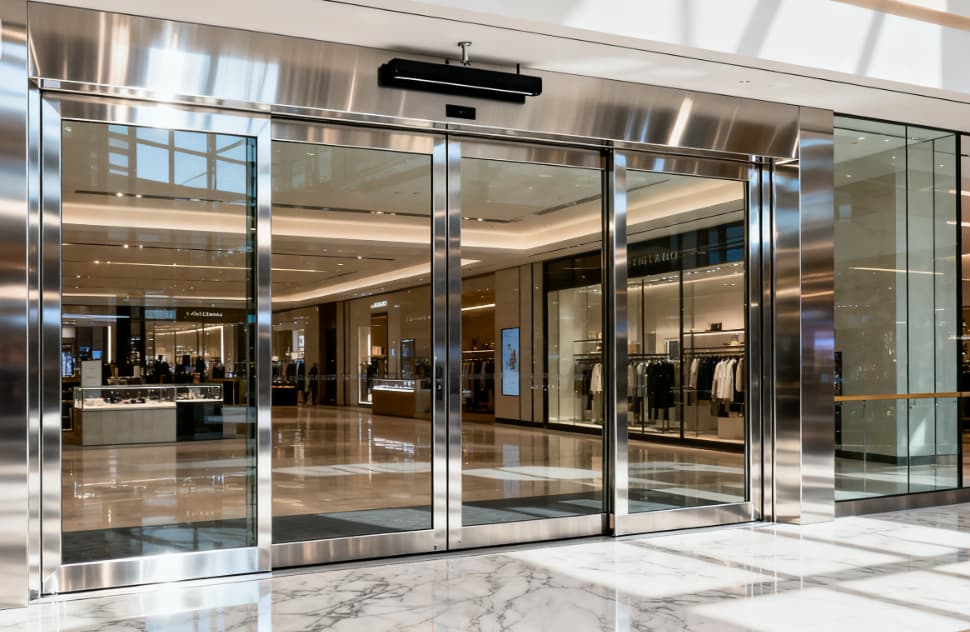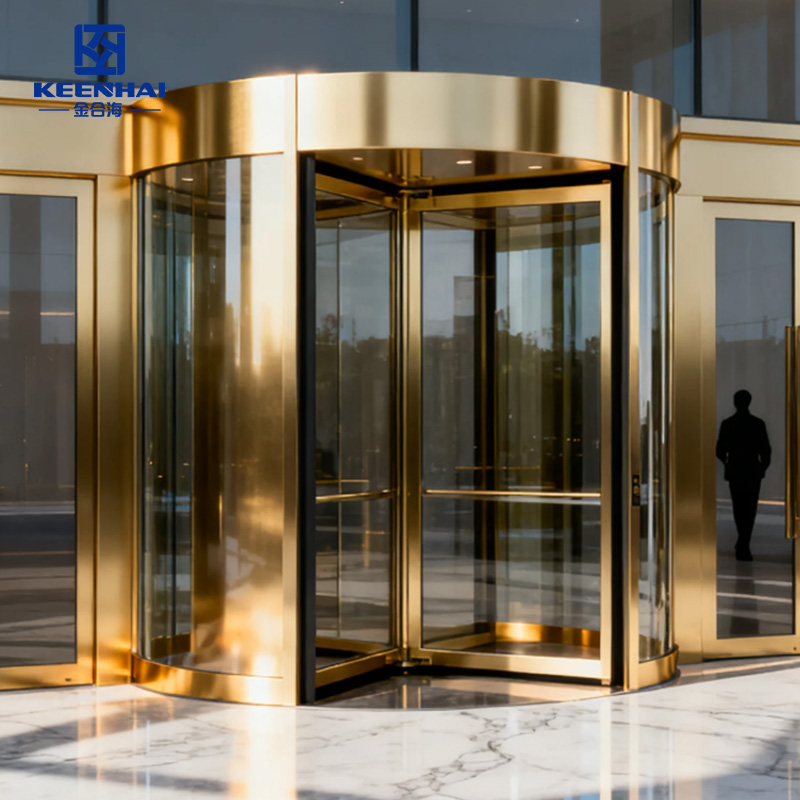Stainless steel sliding doors resist dents, scratches, and corrosion far better than aluminum. Their dense alloy structure and protective chromium oxide layer make them ideal for coastal or high-humidity environments, ensuring years of smooth operation without structural warping. Aluminum is lighter and initially cheaper, but it fades, corrodes, and requires more frequent maintenance. For commercial or high-traffic installations, stainless steel offers a clear advantage in both lifespan and overall reliability.
1. Material Composition and Durability Factors
When evaluating which material lasts longer between stainless steel E aluminum sliding doors, the first factor to examine is the composition of each metal. The makeup of an alloy determines its ability to resist wear, hold structural shape, and maintain aesthetic appeal over time.
Modern stainless steel sliding door systems use a mix of iron, chromium (16–20%), E nickel (8–10%), sometimes enhanced with molybdenum for added corrosion resistance. This blend forms a dense, passive oxide layer that prevents rust, even in coastal or industrial environments. Aluminum alloys—often 6061 or 6063—use magnesium and silicon to improve hardness and machining properties but can’t match the molecular tightness of stainless steel.
This difference becomes critical in architectural projects where doors face high humidity or frequent temperature changes, such as airports, seaside resorts, and large commercial complexes. In these conditions, the stainless steel frame retains alignment and shape much longer, ensuring a smoother glide and better sealing performance over the years.
1.1 Chemical and Structural Properties Comparison
The chemical and structural makeup of these metals defines their mechanical behavior. In stainless steel, the chromium-nickel matrix provides superior density and strength, while aluminum’s advantage lies in its light weight and flexibility. But flexibility isn’t always a good thing—it means a higher chance of deformation under repeated sliding motion.
To put it simply: stainless steel doors behave like engineered armor, whereas aluminum ones function more like lightweight shields.
| Property | Porta scorrevole in acciaio inossidabile | Aluminum Sliding Door |
|---|---|---|
| Main Alloy Composition | Fe + 18% Cr + 8% Ni + 2% Mo | Al + Mg + Si |
| Density (g/cm³) | 7.9–8.1 | 2.7 |
| Elastic Modulus (GPa) | 193 | 69 |
| Thermal Conductivity (W/m·K) | 16 | 205 |
| Structural Rigidity | Very High | Moderate |
| Deformation Tolerance | Minimal | Noticeable under stress |
For instance, in automatic sliding systems used in public buildings, the door’s frame undergoes hundreds of opening and closing cycles daily. A stainless frame maintains its geometry without distortion, while aluminum ones may slowly expand or loosen at joints due to lower elastic modulus. Engineers often note that a 304-grade door can last up to 30% longer under identical operational load compared to an aluminum frame.
1.2 Corrosion and Rust Resistance Over Time
Corrosion behavior is where the two materials really part ways. Stainless steel protects itself through a self-healing chromium oxide film, which automatically repairs surface micro-damage when exposed to oxygen. Aluminum also forms an oxide layer, but it’s thinner and more vulnerable to salt, acidic rain, and cleaning chemicals.
In one coastal construction case in Singapore’s Marina Bay, a row of aluminum-framed doors showed visible oxidation marks within 18 months. After replacement with PVD-coated stainless steel sliding doors from a premium supplier, the surface stayed spotless even after years of exposure to humid, salt-rich air.
The difference lies not just in resistance but also in how each metal reacts to damage. When stainless steel scratches, the oxide layer reforms naturally. When aluminum scratches, it exposes raw metal, accelerating corrosion.
That’s why high-end applications—like hotel entrances or corporate headquarters—prefer Automatic Stainless Steel Sliding Door systems with a brushed or PVD finish. They require minimal upkeep and maintain a consistent visual appeal over decades.
1.3 Weather and Moisture Performance
Weather durability plays a decisive role in lifespan. Stainless steel performs consistently across diverse climates because its thermal expansion coefficient is much lower than aluminum’s. This means it doesn’t warp or expand when temperatures shift between day and night, keeping door alignment intact.
Aluminum doors, while resistant to general moisture, tend to react strongly to temperature variation. In humid regions, the internal condensation can cause frame swelling, which slightly affects the glide track and sealing efficiency.
Here’s what architects typically observe:
-
In tropical climates, stainless steel frames remain stable and rust-free for 20+ years.
-
In cold regions, aluminum frames may contract and create minor alignment gaps over time.
-
In coastal zones, only stainless steel—especially PVD-coated or 316-grade—resists salt air corrosion effectively.
A practical case comes from a hotel in Phuket, where the beachfront entrance used Hotel Automatic Stainless Steel Sliding Doors that withstood both salt spray and high humidity for more than a decade with no structural issues. The same property’s aluminum balcony doors required full frame replacement every six years due to oxidation and warping.
Ultimately, stainless steel’s superior resistance to temperature, humidity, and salt explains why it consistently outperforms aluminum in real-world architectural environments.

2. Strength and Longevity Under Daily Use
2.1 Load-Bearing and Frame Integrity Tests
When doors run thousands of cycles every year, the frame’s load-bearing capacity decides whether the system collapses or hums along for decades. Stainless frames keep their geometry far longer under repeated stress, which directly translates to fewer service calls and less downtime.
Key comparative parameters (practical, on-site focus):
| Parameter | Stainless steel | Aluminum |
|---|---|---|
| Tensile strength (approx.) | 505–620 MPa | 210–250 MPa |
| Fatigue life (approx.) | > 1,000,000 cycles (commercial hardware dependent) | 200,000–1,000,000 cycles (varies by alloy & extrusion) |
| Max recommended single-panel width | ~3.0–4.0 m (larger spans with proper reinforcement) | ~1.8–3.0 m |
| Typical maintenance interval (structure) | 12–24 months | 6–12 months |
| Frame deflection under load | Minimal | Noticeable with heavy spans |
On-site integrity test — step-by-step (do these to verify a new or existing installation):
-
Inspect anchor points: confirm bolts and through-plates show no movement; torque-check bolts to manufacturer spec.
-
Measure panel flatness: use a straightedge over the full leaf width—any continuous gap >3 mm indicates frame distortion.
-
Run a cycle load test: operate the door for 1,000 consecutive cycles at normal speed and watch for track runout, rubbing, or uneven motion.
-
Check fastener elongation: mark bolt heads and re-inspect after 1,000 cycles; any visible elongation means metal fatigue at the connection.
-
Vibration audit: place your hand on the frame while cycling—excessive vibration points to insufficient stiffness or loose hardware.
If you expect >80,000 cycles per year (for example, a busy storefront or transit hub), specify stainless steel frames with reinforced rails. That decision prevents sagging, reduces hinge/roller wear, and preserves alignment.
2.2 Resistance to Dents, Scratches, and Deformation
Durability in daily use equals resistance to the small, repeated insults: shopping carts, luggage, cleaning trolleys, or maintenance ladders. Stainless steel wins here on two counts: hardness and ability to “self-protect.” Its harder surface resists denting and holds finishes (brushed, mirror, PVD) far better than bare aluminum.
Practical performance points:
-
Scratch response: when stainless steel gets micro-scratched, the chromium oxide layer re-forms and masks corrosion risk. Aluminum’s oxide layer doesn’t offer the same mechanical protection; deep scratches expose softer metal and accelerate pitting.
-
Dent resistance: stainless steel’s higher yield strength means it absorbs impacts and returns closer to original geometry; aluminum dents more easily and often requires panel replacement to restore appearance.
-
Repairability: minor surface defects on stainless can be polished out; aluminum often needs section replacement or filler that never matches the original structural tolerance.
If you plan heavy-use installations (hotel lobbies, hospital entrances):
-
Specify minimum material thickness: for heavy traffic, set a door frame gauge that maintains structural stiffness—do not accept the thinnest extrusions.
-
Choose finishes wisely: spazzolato or PVD stainless resists visible scratches; painted or anodized aluminum shows wear faster.
-
Include replaceable wear strips: design tracks and contact points so technicians can swap sacrificial parts without removing the entire frame.
For scratch and dent resistance in high-contact zones, stainless steel clearly outlasts aluminum.
2.3 Performance in High-Traffic or Commercial Areas
High-traffic environments create predictable wear patterns: roller wear, track contamination, seal fatigue, and misalignment. You must think in cycles, not years. For planning, use a simple math check:
-
Example workload calculation: 20 cycles/hour × 16 hours/day × 300 days/year = 96,000 cycles/year.
-
With that load, choose components rated for >1,000,000 cycles to achieve a 10-year service life with routine maintenance.
Operational recommendations for commercial specs:
-
Select heavy-duty rollers and reinforced guides—these reduce lateral play and prevent premature track gouging.
-
Design for serviceability—ensure technicians can access rollers, limit switches, and fasteners without dismantling the frame.
-
Set a preventive maintenance plan:
-
Clean and lubricate rollers and tracks every 3–6 months.
-
Inspect seals and guides every 6 months.
-
Full mechanical audit annually.
-
A large retail chain retrofitted aluminum entrance doors to reinforced stainless frames after noticing alignment drift and seal failure across multiple stores. Post-retrofit data showed 60–75% fewer service calls and firmer seals that lowered HVAC losses.
If a doorway will see more than 50,000 cycles/year or face heavy impact risk, specify stainless frames and commercial-grade hardware. That choice lowers lifetime cost even when initial materials cost more.

3. Maintenance and Aging Performance
3.1 Cleaning and Surface Care Requirements
Regular cleaning is the simplest way to keep stainless steel sliding doors looking new for years. Their dense surface prevents dirt and moisture from embedding, so most homeowners only need a light cleaning routine. Use a soft microfiber cloth with warm water and a mild detergent every two weeks. Avoid harsh cleaners with chlorine or abrasives, which can dull the protective chromium layer. If fingerprints are an issue, wipe with a diluted vinegar solution and dry immediately to prevent streaks.
For aluminum sliding doors, surface care depends on the finish. Anodized or powder-coated surfaces can lose gloss if scrubbed too often, so it’s best to rinse with clean water and use a pH-neutral cleaner. Polished aluminum should be waxed every 6–12 months to prevent oxidation marks. In humid or coastal environments, applying a thin protective sealant can extend the finish’s brightness and slow corrosion.
A consistent routine makes a big difference: stainless steel surfaces retain up to 90% of their original sheen after 10 years, while untreated aluminum often drops below 70% under similar exposure.
3.2 Oxidation and Surface Fading Over Years
Oxidation defines how gracefully a door ages. Stainless steel forms a self-healing chromium oxide film, which continuously repairs minor surface abrasions and keeps corrosion from spreading. Even after decades, the surface tends to darken slightly but doesn’t flake or peel. Type 304 stainless performs well indoors, while Type 316 stainless, with added molybdenum, withstands coastal air and acidic rain with minimal pitting.
Aluminum, by contrast, naturally oxidizes into a dull gray layer that thickens over time. While this layer protects against deeper corrosion, it also fades and loses reflectivity. Painted aluminum shows color loss after about five years under direct UV exposure unless recoated. Once oxidation begins, cleaning cannot fully restore the original brightness, and buffing can remove protective coatings.
When tested under ASTM B117 salt spray conditions, 316 stainless maintained its surface integrity for over 2,000 hours, whereas standard anodized aluminum showed visible oxidation within 600–800 hours. This difference explains why stainless installations retain their appearance far longer, even in cities with high humidity or industrial pollution.
3.3 Typical Lifespan and Maintenance Costs
Under normal conditions, stainless steel sliding doors can remain structurally sound for 25–40 years with routine cleaning and minor lubrication of moving parts. The total maintenance cost typically averages 1–2% of the original installation cost per year. Replacements are rarely needed, and the material’s resistance to denting or frame warping keeps alignment consistent for decades.
For aluminum doors, the expected service life averages 15–25 years, depending on coating quality and exposure. However, repainting, seal replacement, and track realignment are often required every 5–8 years. These tasks increase maintenance expenses to around 3–5% of the initial cost annually in high-use environments.
Over time, stainless proves more cost-efficient despite its higher upfront price. It maintains both mechanical strength and visual appeal with minimal intervention, while aluminum demands more frequent refinishing and hardware replacement. When total ownership cost is considered over 20 years, stainless steel offers about 25–30% better value in durability and upkeep savings.

4. Environmental and Installation Impact on Longevity
4.1 Indoor vs Outdoor Installation Durability
The environment where a door is installed has a direct impact on its lifespan. Stainless steel sliding doors installed indoors, in controlled climates, experience minimal wear from weather and moisture. They maintain structural alignment and surface finish for decades with basic cleaning. Indoor use avoids prolonged UV exposure, salt, and humidity, which can accelerate wear on most metals.
Outdoor installations face harsher conditions. Stainless steel still outperforms aluminum due to its corrosion-resistant alloys, but it’s important to choose higher-grade steel, such as 316, for coastal or industrial environments. Aluminum doors exposed to sunlight, rain, or salt air tend to fade, warp, or corrode more quickly unless regularly coated or maintained.
4.2 Climate Influence: Humidity, Salt Air, and UV Exposure
Humidity, salt, and UV light are three major factors that dictate how quickly a door shows signs of aging. Stainless steel doors resist oxidation and warping even in high-humidity climates because of the protective chromium oxide layer. Coastal hotels and seaside resorts often install Hotel Automatic Stainless Steel Sliding Doors to withstand salty air, and they maintain smooth operation for over a decade without major maintenance.
Aluminum doors react differently. In high-humidity or salty environments, even anodized or powder-coated aluminum can develop corrosion spots. UV exposure fades paint and accelerates surface degradation, leading to an uneven appearance. For outdoor applications, stainless steel combined with protective coatings like PVD ensures long-term durability and minimal visual deterioration.
4.3 Effect of Improper Installation on Material Lifespan
Installation quality directly affects the longevity of both stainless steel and aluminum sliding doors. Poor alignment, insufficient anchoring, or uneven mounting can lead to track wear, roller misalignment, and stress on the frame, which significantly shortens service life.
Steps to ensure proper installation:
-
Level the frame using a precision spirit level; even a 2–3 mm deviation can cause uneven wear.
-
Secure anchor bolts to structural recommendations; loose anchors lead to frame deformation over time.
-
Check roller alignment and lubrication before daily use; misaligned rollers increase stress on the panels.
-
Seal gaps appropriately to prevent water ingress; moisture trapped inside the frame can accelerate corrosion.
-
Inspect after initial cycles; run 50–100 opening cycles to ensure smooth motion and check for undue strain on the frame.
Even high-grade stainless steel sliding doors can underperform if installation is poor, whereas proper installation maximizes material advantages. Aluminum doors are even more sensitive to installation errors because their lower stiffness magnifies misalignment effects, leading to faster deformation and maintenance requirements.

5. Cost-to-Lifespan Comparison
5.1 Initial Investment vs Long-Term Value
High-quality stainless steel doors typically carry a higher upfront cost than aluminum alternatives, but that initial premium pays off over the years. The material’s resistance to dents, warping, and corrosion reduces the need for frequent repairs or replacement. Aluminum doors cost less at purchase, but their lower structural strength and susceptibility to fading, oxidation, and deformation often result in additional expenses within a decade.
When considering long-term value, the picture becomes clear: a 316-grade sliding door in a commercial lobby may cost 40–60% more initially than aluminum, but it often lasts 25–30 years with minimal maintenance, while aluminum may require panel replacements or refinishing every 7–10 years. Over a typical 20-year period, the total cost of ownership for stainless steel is usually lower than aluminum, especially in high-traffic or harsh environments.
5.2 Repair, Replacement, and Downtime Costs
Repair frequency significantly impacts total expenditure. Aluminum frames tend to show wear sooner—track alignment shifts, surface oxidation develops, and panels can dent easily. These problems not only increase maintenance costs but also create downtime, which can be costly in commercial or public applications.
Stainless steel, with its superior hardness and corrosion resistance, keeps maintenance intervals longer and replacement cycles rare. For example, in a hotel entrance installation, replacing aluminum panels once every 5–7 years involved labor, downtime, and temporary closure of entrances, while stainless frames remained fully operational without interruption. The reduced downtime and fewer repairs translate to tangible cost savings, even if the material cost is initially higher.
5.3 Overall Durability ROI: Stainless Steel vs Aluminum
When factoring initial purchase, maintenance, repair, and service life, the return on investment for stainless steel doors is significantly higher. Over 20–25 years, a properly installed stainless system maintains mechanical performance, surface finish, and structural integrity, avoiding repeated costs associated with aluminum’s shorter lifespan.
For high-use areas like airports, corporate headquarters, or luxury hotels, choosing stainless steel ensures that the door continues to function smoothly, retain its visual appeal, and require minimal intervention. While aluminum can be sufficient for low-traffic or indoor applications, it rarely matches the long-term durability and ROI of premium stainless steel sliding systems.




